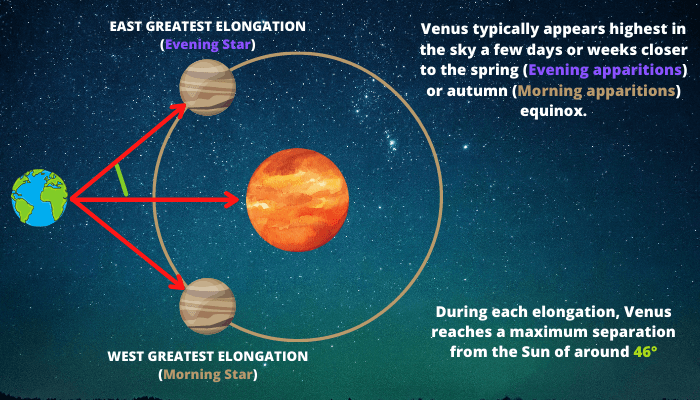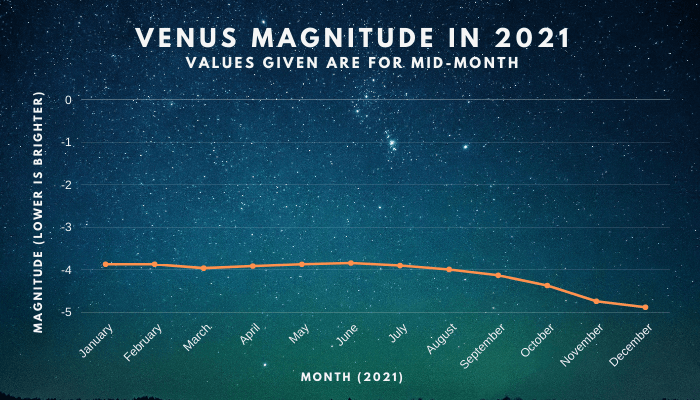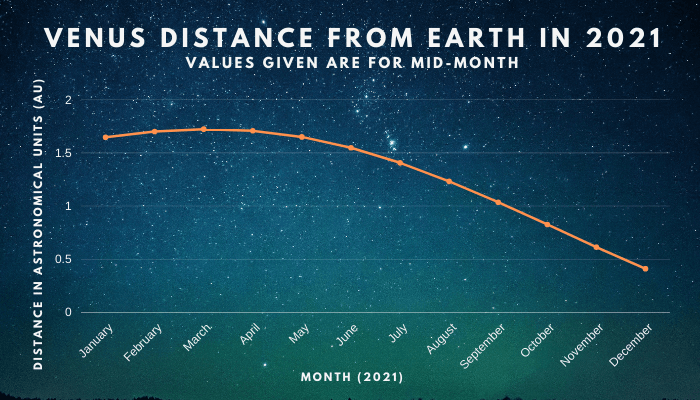Venus is one of the most prominent features in Earth’s sky and it has been since the dawn of human civilization. After the sun and the moon, Venus is the brightest object in our sky which makes it easy to spot with the naked eye. In fact, even if you don’t know it, Venus is probably one of the things in the sky you’ve seen the most.
While easy to spot with the unaided eye, our neighbor simply appears as a bright star. How can you see Venus through a telescope? What will you see if you train your telescope on Venus?
Here are the steps you need to take to find Venus in your sky and a good idea of how best to view it once you do.
The Wandering Star

The first thing to note about Venus is that despite its appearance as a star, it is most definitely a planet. If you are sitting there saying “well duh” it is important to know that planets in our solar system move much differently than distant stars.
Since antiquity, Venus has been known as the wandering star. That is because, without a telescope or advanced knowledge of Venus as a planet, it does very much look like a star. However, it does not move or behave like a star.
Stars and constellations follow static and fixed paths across the sky and move as the seasons change. This is because as the Earth rotates around the sun, the position of far off stars rotates in relation to our motion.
Venus, on the other hand, is also rotating the same star we are rotating around. This makes Venus appear to wander through the other constellations as the seasons change. Instead of simply slowly rotating around as the stars do, Venus rises and falls and plows its own path through the night sky.
All of this to say, that while Venus is the brightest object in the night sky after the moon, knowing where to look for it on any given day can be tricky.
Morning and Evening Star
The second thing to make note of regarding Venus’s position in the sky is that it will closely follow that of the sun. Since Venus is closer to the sun than the Earth and also rotates around the sun, it will be near the sun in the sky as well. This is why Venus is known as the morning or evening star.
Depending on the time of year, Venus either appears just after sunset or just before sunrise. Unlike the moon which rises, crests, and sets like the sun, Venus appears just after or before the sun before disappearing again. This can make it hard to pinpoint and view with a telescope.
During some parts of the year, this leaves Venus very close to the horizon which can make it difficult to view with a telescope. It can also lead to having too much preglow or afterglow lighting that can wash out your telescope’s viewing capabilities.
The first step to viewing Venus with a telescope is to find out where it will be and at what time. Sometimes it will be at dawn and other times it will be at dusk. There are plenty of online schedules and astronomy apps that can help to find Venus’s location at any given time.
Due to its familiar presence and prominence in the sky, it will be easy to locate once you know where and when to look. There should be no guessing involved. Once you have located Venus you are ready to train your scope on our closest neighbor and give it a look.
When is the best time to observe Venus in a telescope?
Venus is the second closest planet to Earth, this means that it can only be seen in either morning or evening skies. But because Venus moves close behind and ahead of the Sun’s path across our sky during its orbit, there are rare moments when you might see a crescent-shaped silhouette against bright twilight before sunrise or dusk after sunset.
The inner planets are always close to the Sun because they orbit closer than Earth. But every once in a while, Venus reaches its greatest elongation of 46 degrees from the Earth and Sun line: this special moment can happen between one or two times per year, but some years there may not be any at all!
The time of day is significant for observing Venus with a telescope as the planet will set in the horizon about 3 hours after sunset (East greatest elongation) or rise about 3 hours before sunrise. This is called elongation and represents the best opportunities to observe Venus.

When is Venus at its brightest in the sky?
The planet Venus will become brighter starting in early January to mid-July and then again from late September. In 2021, the planets’ greatest brightness of the year is going to happen twice: once on March at mag -3.9 followed by another time around December at a magnitude of -4.88!
The best time to observe Venus this year is around October 29, shortly after sunset.
You can see that throughout the year, Venus shines at a consistent level. As winter gives way to spring, this number falls and Venus shines brightest (the lowest magnitude).

The closer the object is to us, the brighter it appears in our sky. As Venus moves closer to Earth as we get to the end of the year, so its brightness changes during that time period.

Venus looks larger in the latter part of 2021 as you may expect. It goes bigger as we move throughout the year and is the smallest in early months of 2021.
We take a look at the below chart that tracks the size of Venus during 2021. The diameter is taken from the middle of each month and is measured in arcseconds.

Between October and December, when Venus is at its peak size, it will be more than two-and-a-half times the size that we’ll see earlier in the year.
Choosing A Telescope
The next step is choosing the best telescope for the job. If you only have one telescope, then it will have to do. Due to Venus’s close proximity to Earth, typical angles in the sky, and time of day it appears, it is going to be much better to view Venus through a low-powered refractor than anything else.
Since Venus is so bright, you are not going to need a ton of magnification to get a good image of the planet. The more powerful the telescope, the more washed out the planet might appear since it gives off so much light.
You are also going to want to attack Venus with a telescope that has a high focal ratio. Since Venus is a small, close, and bright object you are going to want the most contrast and a narrow field of view to get the best look at it.
A wide angled telescope is going to show you Venus but it is going to be a lot smaller and less defined than if you are using a refractor telescope with a narrow angle view.
Our Recommend Telescopes For Viewing Venus
The best telescope for viewing Venus would be a 70mm refractor with a focal ratio of 10 or above. Other telescopes will still get decent views of the planet but this kind of telescope will give you the best shot of getting a truly special view.
You can use our telescope comparison table to pinpoint the perfect telescope quickly. At the time of writing the Celestron AstroMaster 70AZ, Celestron PowerSeeker 70EQ and the Meade Polaris 70 EQ met the requirements just right.
Since Venus is up there in brightness with the moon, you can safely use a moon filter to try and block out some of the excess light that the planet emits. This can help get you a better, more defined image and it can also help to filter out any excess light that might be present due to the sun.
Venus likes to appear in the sky when there is still a decent amount of sunlight in the air and this can prevent telescope users from getting a great view of the planet.
This is why Venus, while a breeze to see with your naked eye, can be tricky to see with a telescope. A moon filter or any other filter aimed at removing excess light from the viewer will go a long way in clearing up your images of Venus.
What Will You See?
Venus is made up of extremely dense and reflective clouds. This is why it appears so bright in the night sky, it reflects a ton of light from the sun towards the Earth. These clouds, while they make for a great view of Venus with your eyes, can make it tricky to get any good views of Venus with a telescope.
You will not be able to see the surface of Venus like you can with other objects. The moon and Mars derive their viewing appeal from seeing their surfaces. The moon has a whole host of interesting surface features and the red color that you see on Mars is the planet’s landmass. You will not see any such features with Venus.
Unlike Jupiter or Saturn, you also won’t see many interesting cloud bands or formations. First, Venus is much, much smaller than the gas giants so seeing defining features of it is a lot harder because of the brightness and proximity to the sun in relation to Earth.
Why View Venus
The biggest appeal to viewing Venus is seeing it in relation to the sun. Venus will go through phases, much like the moon, where it will change shape over time. This is one of the best things to observe with a telescope.
You can also keep track of interesting events such as Venus’s transit of the sun which is a big event. Since Venus moves within our solar system, you can catch it in interesting positions and a telescope can help to bring these events to their maximum potential.
On the right night, with the right telescope and the right sky conditions, you can get some clear images of Venus’s yellow clouds. Unfortunately, images like that are going to be rare due to the many variables that must be correct in order to get a clear view like that.
Easy Yet Hard
Running against what you think would be common sense, Venus is simultaneously easy to see yet very difficult to get a good bead on. It is easy to find in the sky but hard to get to come into focus. It will shine through most nights but can be too bright to see properly. Venus will rise just before or after the sun but never be as prominent as it.
Getting a great image of Venus with a telescope can be an excellent mission for a new astronomer. Viewing it can be tricky but it is never frustrating. It is one of the best night sky features to try and practice your skills as a new stargazer.
First, look up where the wandering star will be in the night sky in your location and your time of year.
Next, choose the best telescope for the job and set up just before dawn or just after dusk, depending on what you found out in step one.
Lastly, get a good bead on the planet and use light filters if needed. Take special notice of Venus’s coloring, it’s brightness and it’s phase in relation to Earth and the sun. If you keep it up, one day you’ll get a truly spectacular, high contrast, vibrant picture of our closest neighbor.
Conclusion
We hope that this guide to viewing Venus through a telescope has helped you to gain some new information about this fascinating little planet and to learn a bit more on how to best observe it.
Investing in a telescope is always a worthwhile way to spend your money, and astronomy can be a very enjoyable hobby.
If you enjoy Observing Every Planet Through A Telescope then you will love that we have on offer Mars, Saturn, Jupiter, Mercury, Neptune, Uranus guide to help you get the best views. If you enjoy plant facts we also have this topic covered including Venus facts that I hope you enjoy.



